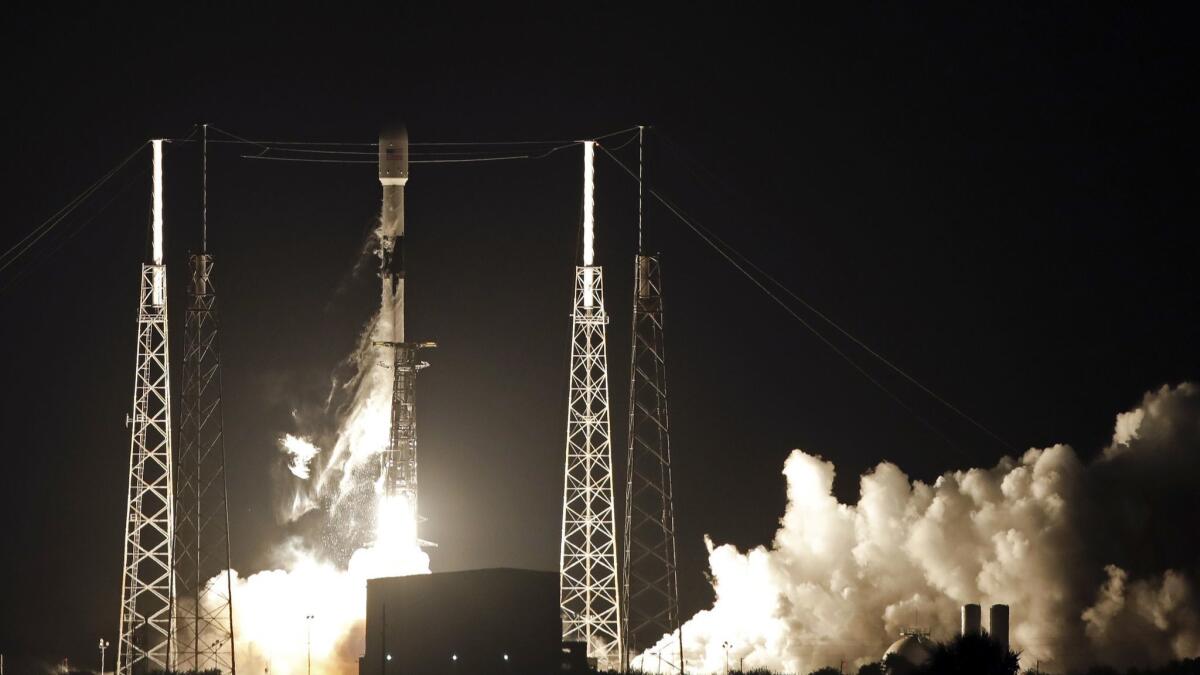SpaceX faces daunting challenges if it’s going to win the internet space race
Elon Musk and SpaceX have staked their legacy on a spaceship capable of carrying a hundred passengers to Mars. But to pay for that dream, the Hawthorne company is banking on a project that is ambitious in its own way: selling broadband internet service delivered by more than 1,000 small satellites.
Chief Executive Musk has mused to reporters about the technological hurdles facing SpaceX’s Starlink constellation, including antennas that track the satellites as they move through the sky and laser communication systems that allow the spacecraft to talk to each other. Last month, SpaceX launched the first 60 satellites of its planned constellation.
But industry experts say the company’s biggest challenge is financial. SpaceX must drive down the cost of sophisticated hardware and software to the point where it can deliver fast, reliable internet service at a price point that competes with cable or fiber-delivered broadband services, while finding enough underserved markets to provide scale.
SpaceX President Gwynne Shotwell hasn’t been shy about the hurdles Starlink faces.
“This is probably one of the most challenging, if not the most challenging, project we’ve undertaken,” she said during an onstage conversation at a TED conference last year. “No one has been successful deploying a huge constellation for internet broadband. I don’t think physics is the difficulty here. I think we can come up with the right technology solution, but we need to make a business out of it.”
Here’s a look at what Musk and SpaceX must overcome:
Finding a market
SpaceX previously said its broadband coverage would be aimed at customers in the U.S. and around the world, “including areas underserved or currently unserved by existing networks.” In mid-June, Musk seemed to narrow the scope, telling shareholders of Tesla Inc. — Musk’s other high-wire venture — that the broadband plan’s main value was in providing internet access to “rural or semi-rural areas, places that don’t have connectivity right now.”
In 2017, more than 26% of people who lived in rural areas in the U.S. were not covered by terrestrial broadband internet service, according to a May report from the Federal Communications Commission. Industry experts have estimated that only 10% to 20% of the Earth’s land area is covered by terrestrial cell towers.
“It’s probably able to serve 3% to 5% of people in the world, but it’s actually not ideal for high-density cities,” Musk said. “It’s really to serve the unserved or poorly served.”
If successful, Starlink will be a major boon for SpaceX’s business and would diversify the company’s revenue streams beyond rocket launches. During a call with reporters last month, Musk estimated that, with a successful Starlink service, SpaceX could grab at least 3%, or $30 billion, of a $1-trillion global internet connectivity market.
That’s important since Musk said the company’s launch revenue probably “taps out” at about $3 billion a year.
“We would need the revenue from Starlink to fund Starship,” he said during the May teleconference with reporters, referring to the company’s Mars spaceship. “We think this is a key steppingstone on the way to establishing a self-sustaining city on Mars and a base on the moon.”

Space is about to get crowded
SpaceX faces a range of competitors, including London-based OneWeb, which is backed by Japan’s SoftBank Group Corp. and British billionaire Richard Branson’s Virgin Group, and LeoSat Enterprises, a Washington, D.C., company that has partnered with major European satellite maker Thales Alenia Space. Heritage satellite manufacturer Boeing Co. has also submitted paperwork to the FCC proposing its own satellite broadband constellation. Just recently, Amazon.com Inc. entered the race.
Of these, only OneWeb has actually launched satellites for its constellation.
Musk said during the May teleconference that he figured there would be at least one other satellite constellation in low-Earth orbit, besides SpaceX’s, and that having more than one provider would be “the best thing for the consumer.”
“At the end of the day, it’s always good to have competition,” he said.
But having as many as three to four providers in the market is “very unlikely, unless they are very differentiated,” said Carissa Christensen, chief executive of analytic consulting firm Bryce Space and Technology. And first movers may not necessarily have an advantage here — providers that are convenient, well-priced and have an “extremely high-performing product” will probably win, she said.
Satellites are only part of the equation. These operators also need to get the Earth-bound architecture in place, including user terminals to access the service. In a space-based internet system, customers must have a device in their home to receive and transmit signals from satellites as they cross the sky.
“There’s a lot to getting an entire system and network established,” said Suzi McBride, chief operations officer of satellite operator Iridium Communications Inc.
McBride worked on the Iridium program for Motorola Inc. from 1993 to 1999, when the company was the lead investor in the original Iridium satellite constellation. That operator filed for Chapter 11 bankruptcy protection after subscriber growth did not meet expectations. Iridium was later acquired by an investor group.
“There’s a lot of focus on satellite systems, but there’s more to it than satellite systems,” she said.
SpaceX’s development and initial build-out costs for the constellation are apparently already covered. The company raised $535.7 million in an equity offering that began in April and another $486.2 million from a round initiated in December, according to filings with the Securities and Exchange Commission dated May 24 — the day after the company launched its 60 Starlink satellites.
Musk said before the launch that the fundraising, along with launch revenue from commercial satellites and NASA contracts, would generate enough capital for the company to get the internet plan to an “operational level.” The constellation could reach initial operational capability with 360 satellites, he said.
“But of course, if things go wrong … we’ll need to raise more capital in that situation,” Musk said in May. He described the entire constellation as a “multibillion-dollar endeavor;” last year, Shotwell estimated it would cost the company $10 billion or more to deploy the system.
Musk has a lot at stake. Bloomberg reported Tuesday that SpaceX now makes up two-thirds of Musk’s wealth, based on the private company’s most recent valuation of $34 billion.
But Christensen pointed to SpaceX’s record of wedging past veteran competitors in the launch business. “It took away business from very established launch companies with a brand-new capability,” she said. “So SpaceX certainly has a track record of success in competing.”
High tech at low cost
Beyond start-up costs, satellite experts say affordable internet service will depend on how cheaply SpaceX can make components.
Some parts, such as phased array antennas, have benefited from improvements in silicon chip technology, which reduced the size and price of electronic components, said Gabriel Rebeiz, a distinguished professor of electrical and computer engineering at UC San Diego.
Unlike a dish antenna, which is perched atop a customer’s house and aimed at a fixed spot where it can connect with its corresponding satellite, a phased array antenna can electronically change its beam to meet constantly moving satellites in low-Earth orbit, such as the Starlink spacecraft. The antenna itself looks like a large, flat serving tray — Musk has said the Starlink antenna is about the size of a medium pizza — and is reliable because it involves no moving parts, Rebeiz said.
On Friday, SpaceX said in a statement that 57 of the 60 satellites were communicating with ground stations using their phased array antennas.
When these antennas were first developed more than 30 years ago, they could cost $100,000 or more to make. Today, manufacturing costs range from $300 to $500, Rebeiz said. By comparison, a DirecTV dish costs only $50 to make, but it has much less capability, for instance, being only able to transmit data and communicate with one satellite, he said.
That will be key to keeping the price of user terminals low — about $100 each is a good goal, said Kerri Cahoy, associate professor of aeronautics and astronautics at MIT.
For any satellite constellation to be “really, really economically viable,” user equipment needs to be sold at three to four times the operator’s monthly service rate to make back investments, said Bulent Altan, head of space at laser communication technology manufacturer Mynaric and an early SpaceX employee who served as vice president of satellite mission assurance from 2016 to 2017.
“It will be a make-or-break factor,” he said.
Another manufacturing challenge for Musk?
SpaceX’s first 60 satellites took a few months to build at the company’s Redmond, Wash., satellite facility, but Musk said in May that the company aims to get that down to a batch at least every two weeks — a rate it could reach by the end of the year.
He likened the ramp-up to Tesla, which went from producing 500 to 600 two-seater Roadsters per year to manufacturing 1,000 cars a day, he said. But the company’s shift to higher-rate Model 3 car production was fraught with difficulties, including a wholesale rethinking of the company’s approach to automation, which led Musk to describe the process as “production hell.”
For SpaceX, the question will be whether it can outperform competitors — including OneWeb Satellites, a joint venture of OneWeb and Airbus that will soon open a high-volume satellite manufacturing facility in Florida — on cost and production efficiencies.
SpaceX has not yet released details about its pricing and costs. Rival OneWeb has said it is aiming for a user terminal price of $200 to $300.
“Nothing that they’re proposing is impossible to build,” Cahoy said of SpaceX’s plan. “The question is, can they do it cost-effectively enough to have a profitable business?”
And targeting sparsely populated areas means SpaceX needs to be even more aware of its user pricing. If SpaceX is providing service in an area that’s not served by mobile phones, Christensen said, “is the price point consistent with what people in that area can pay?” In mostly rural counties in the U.S., the median annual household income is about $47,000, according to the 2010 census.
Remote customers could include cruise ships and passenger planes, which already provide internet access to customers via satellites. In those cases, SpaceX would face established competition and would have to deliver high reliability, Christensen said.
Musk said last month that SpaceX had not yet tried to sign up any customers for Starlink — largely because it wanted to make sure it was confident in the timing and quality of the constellation — but was interested in talking with potential strategic partners around the world, including telecommunications companies or governments.
Of the 60 satellites launched last month, 45 have already reached their operational altitude, SpaceX said Friday. Two satellites are intentionally being de-orbited to test “end-of-life disposal,” while three that initially communicated with the ground but are no longer in service will passively de-orbit. Ten others are either continuing to raise their orbits or going through last checkouts before that orbit raise, SpaceX said.
The company will test the satellites’ capacity and speed by “streaming videos and playing some high-bandwidth video games using gateways throughout North America,” SpaceX said.
But McBride has a word of warning for SpaceX from her experience at Motorola: Watch for market shifts, particularly as the constellation is being built out. After all, Iridium’s plan to offer satellite phone service was undercut by cheaper ground-based systems.
“It’s not just the [low-Earth orbit] competitors you need to watch,” she said. “You have to watch all the markets and all the technologies that may come into existence.”

More to Read
Inside the business of entertainment
The Wide Shot brings you news, analysis and insights on everything from streaming wars to production — and what it all means for the future.
You may occasionally receive promotional content from the Los Angeles Times.











